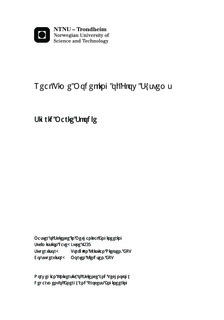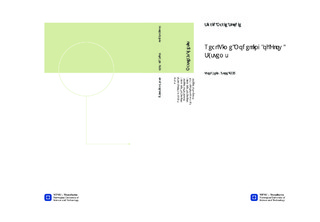| dc.contributor.advisor | Nielsen, Torbjørn Kristian | nb_NO |
| dc.contributor.advisor | Kjeldsen, Morten | nb_NO |
| dc.contributor.author | Skodje, Sigrid Marie | nb_NO |
| dc.date.accessioned | 2014-12-19T11:50:57Z | |
| dc.date.available | 2014-12-19T11:50:57Z | |
| dc.date.created | 2013-09-19 | nb_NO |
| dc.date.issued | 2013 | nb_NO |
| dc.identifier | 649757 | nb_NO |
| dc.identifier | ntnudaim:9418 | nb_NO |
| dc.identifier.uri | http://hdl.handle.net/11250/235216 | |
| dc.description.abstract | Hydro power plants are operated in a different manner than what they used to be, due to increased focus on economy, and less on operating on best efficiency point. This creates new challenges related to wear and tear of the plant. In order to maintain and avoid degradation, the need for control is increased. Installing sensors in a hydro power plant may be difficult, and modeling and estimating parameters could be a solution. This thesis will cover real time modeling of flow systems, with particular focus on the Kalman filter. The filter is an important part of control engineering, but the utilization in hydro power seems to be limited. The goal of this thesis is to understand how the Kalman filter works for hydro power applications, and how it can be implemented in LabVIEW. The Kalman filter investigated is the nonlinear Discrete Extended Kalman filter. The case chosen is the estimation of flow, based on two different pressure losses. The Kalman filter program was run at different operating points in order to investigate the filters function on the dynamics of the system. The experimental rig used was the existing Swirl rig at the Water Power lab at NTNU. Some modifications had to be made in order for the rig to fit the experiment specifications. One of the main valves were changed, and some extra pressure outlets were made. Both flowmeters, absolute pressure transducers and differential pressure transducers were used for the experiment, all of these calibrated by the calibration program presented. The calibration includes uncertainty analysis. Both the calibration program and the Kalman filter program is presented step by step in order to describe the features and logic behind the programming. The main part of the results seemed to coincide with the Kalman filter theory. The estimations of the flow based on pressure loss over the valve seemed to follow the measured values, but the estimations for the pressure loss over the swirl generator did not. Some of the estimations showed reduction in loss compared to the measurements. These and more results are presented and discussed. | nb_NO |
| dc.language | eng | nb_NO |
| dc.publisher | Institutt for energi- og prosessteknikk | nb_NO |
| dc.title | Real Time Modelling of Flow Systems | nb_NO |
| dc.type | Master thesis | nb_NO |
| dc.source.pagenumber | 149 | nb_NO |
| dc.contributor.department | Norges teknisk-naturvitenskapelige universitet, Fakultet for ingeniørvitenskap og teknologi, Institutt for energi- og prosessteknikk | nb_NO |

